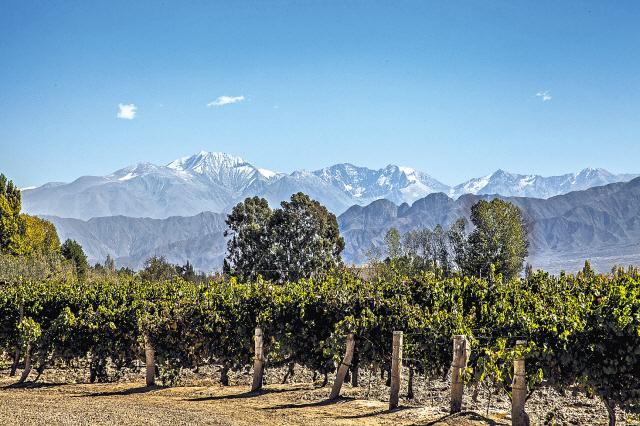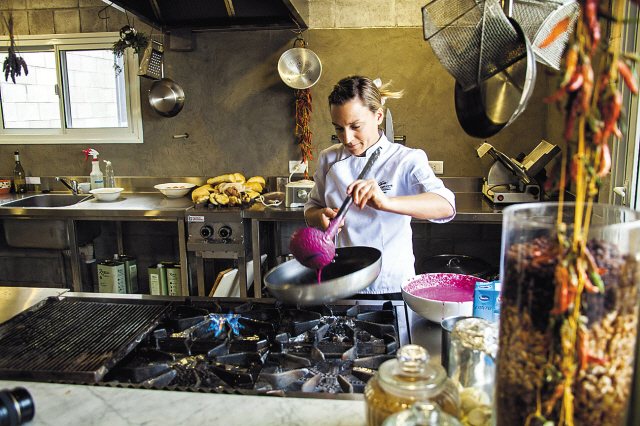MAIPU, Argentina ― Ten minutes in the orchard and already my hands felt raw. How do they do this all day without gloves, I wondered, shuffling my feet for a better foothold in Argentina’s sandy clay.
It was Thursday, the day we’d expected to be tasting wine at the Zuccardi family’s finca (ranch) and winery, in Maipu, Mendoza Province. Instead, we were clawing through a tangle of branches, trying to pick enough olives to feed Zuccardi’s state-of-the-art olive oil press.
It looked so easy when Torey Novak, Zuccardi’s tour guide, gave a demonstration. You hang a cone-shaped canvas sack around your neck and pick a tree loaded with ripe fruit. Reaching up into a branch, you grab it with both hands and yank down hard, stripping the olives off and into the sack. When your neck cries uncle, you empty the sack into the 40-pound crate handily stacked nearby. Then you fill the second crate, and the third, all day every day until the harvest ends or your hands scream uncle.
“Nah, most good pickers don’t wear gloves,” said Novak, amused. He could see I was hopelessly awkward. “I couldn’t do it either,” he admitted. “Not for long, anyway. But our best picker can fill 45 crates in a day.” Mercifully, my career as a field hand died before it was born.
But why in blazes were we fooling with olives when we’d left Buenos Aires three days earlier on a mission: to smell, savor, taste and compare Malbec, Argentina’s signature red wine, at the source? And why was “La Familia Zuccardi,” a family-owned, three-generation-old winery and leading Malbec producer, growing olives?
 |
The snow-capped Andes Mountains rise above the vineyards at Vistalba Winery in Mendoza, Argentina. (Stever Haggerty/MCT) |
As it happens, a number of long-established wineries here in the Cuyo area, scrubby desert land on the sunny east slope of the Andes Mountains, grow multiple crops. The soil, irrigated for centuries before Europeans explored the region, is ideal for growing both grapes and olives; more than 6,000 olive growers and 1,200 wineries are scattered through the two adjacent provinces of Mendoza and San Juan.
The region’s newer wineries stick mostly to grapes, concentrating their efforts on building sales. But for visitors to the region, the complete farm-to-bodega tour adds another dimension altogether. When you’ve mucked around in the man’s orchards and harvested his olives, you feel invested.
After picking the fruit, clumping through the mud and riding back to the processing plant with the crates stacked on the golf cart, we watched our olives macerated into mush. Tasting the newly pressed oil, we proudly pasted labels on our take-home bottles. Then we knocked the dirt off our shoes and headed for the bodega itself.
Here, in the Casa Del Visitante, sepia-toned photos serve a slice of late 19th century history, capturing tired-looking Italian immigrants toting luggage, working the fields, picking grapes and vegetables and building railroads. Framed photos of Zaccardi’s founding ancestors, frozen in ankle-length dresses and high collars, highlight the exhibits. Then it was on to the fermentation vats and eventually to the tasting room. The tour ended not with a “we’re done, let’s go,” but with a traditional Argentine meal prepared by Chef Ana Rodriguez at the winery’s casual cafe and food shop, the Pan y Oliva.
 |
Chef Ana Rodriguez prepares traditional dishes at the Pan y Oliva cafe at the Zuccardi Winery in Mendoza, Argentina. (Stever Haggerty/MCT) |
For wine aficionados, Mendoza is a destination in its own right. One way to get there is by flying through Miami to Santiago, Chile, and east over the Andes (a short flight or drive) into Argentina. But for us, the winery visits were an add-on, a last minute addition to a family reunion in Buenos Aires. Our third cousins in Buenos Aires (newly-discovered on Facebook) had invited us to visit more than once. When they proposed a trip to Mendoza, heart of the world’s fifth largest wine industry, we couldn’t say no.
What we’d forgotten is that Argentina is nearly as large as the United States (four times the size of Texas); Mendoza, 646 miles west of Buenos Aires, is hardly a weekend getaway. And with limited vacation time, flying was the only option. We’d rent a car at the airport, we assumed, and explore the wine country on a relaxed schedule, just as we’ve done in California’s Napa and Sonoma, in Oregon, in Washington state, even in France.
But that isn’t the way they do it in Mendoza. Because the wineries are scattered far apart and road signs are poor, drop-in guests are non-existent. Instead, you call or email and make a reservation for a specific time. On the appointed day, the bodega schedules a staff member to conduct the tasting, chooses sample wines and polishes the wine glasses.
Anyone can make a reservation for a visit and tasting. But there are advantages to signing up for a one- to five-day tour with a wine tour company, someone who knows the industry, the wineries and Argentine culture. It’s akin to renting an audio guide when you visit an art museum. You come away better informed and certainly more entertained.
A typical tour ― you choose the length ― generally visits three wineries each day and includes daily lunch (with wine), hotels and transportation by van. If you have specific wine labels or vintages in mind, they’ll customize your route. Our cousins, who knew the drill, handled it for the four of us, arranging a three-day guided tour with a guide they’d used before.
We started in San Juan Province, going first to Callia Winery and then to Graffigna, where Chief Wine Maker Gerardo Danitz, eager to answer even the dumbest question, fielded a tasting that could have doubled as Wine Wisdom 101. His patient explanations were an ideal send-off for what would be three days of tasting, spitting, tasting, sneaking a swallow here and there ― for the strength to push on ― and running out of adjectives to describe the infinite range of fruity, nutty flavors.
Heading south to Mendoza, we stopped first at Vistalba Bodega, wine czar Carlos Pulenta’s show place, where most visits include both tasting and lunch at his much-acclaimed five-star restaurant, La Bourgogne. Then it was on to Tupungato Winelands to see recently planted vineyards and the new golf course; to Salentein and a culture museum; and finally to Zuccardi. Which is how we found ourselves in the dirt, discussing olive cultivation.
Until then I hadn’t given much thought to immigrant history and the parallels between Argentina and the United States. But in most of the towns we saw, you could walk down the street and ― except for the signs in Spanish ― think you were at home. Both countries were settled by immigrants from Europe who brought farming skills to the New World. Settling in places like Wisconsin, Iowa, Virginia and throughout Argentina, they saw what looked like empty land, and displacing or killing the indigenous tribes, claimed it.
Early Spanish explorers and missionaries had already introduced grapes and cattle; with land to spare, beef cattle, herded by cowboys in the U.S. and by gauchos in Argentina, became a staple. And grapes, initially grown for the fruit or to make table wine for home use, became a commercial success.
Like Argentina’s immigrants, Malbec grapes are also an import, brought from France. But it took Mendoza’s sandy clay to create those tongue-tingling perfect fruity, nutty, oaky, you-name-it flavors. A wine bottle, tucked into my luggage for the return trip, would have been nice. But the custom-picked, personally selected, orchard-to-table olive oil made a better souvenir.
By Anne Z. Cooke and Steve Haggerty
(McClatchy-Tribune News Service)
(MCT Information Services)






![[Exclusive] Hyundai Mobis eyes closer ties with BYD](http://res.heraldm.com/phpwas/restmb_idxmake.php?idx=644&simg=/content/image/2024/11/25/20241125050044_0.jpg)
![[Herald Review] 'Gangnam B-Side' combines social realism with masterful suspense, performance](http://res.heraldm.com/phpwas/restmb_idxmake.php?idx=644&simg=/content/image/2024/11/25/20241125050072_0.jpg)

